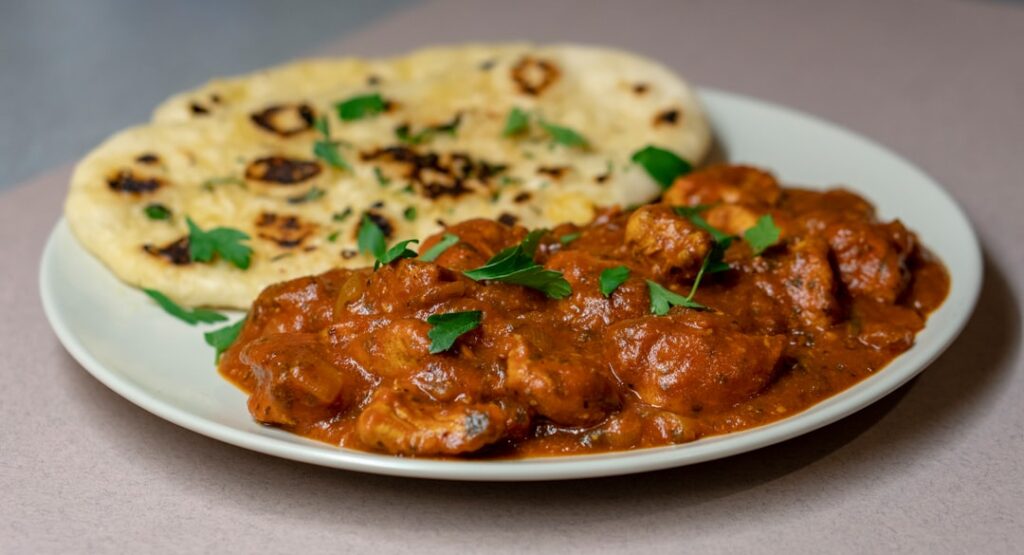Why Indian Food Represents One of the World’s Most Complex Culinary Traditions
Indian food consists of diverse regional cuisines that reflect an 8,000-year history of cultural interactions, making it one of the most varied and sophisticated food systems on Earth. Here’s what defines this incredible culinary landscape:
Key Characteristics of Indian Food:
- Regional Diversity: Over 30 distinct state cuisines with unique ingredients and techniques
- Spice Mastery: India produces 75 of the 109 spice varieties recognized globally
- Ancient Roots: Cultivation of rice, lentils, and spices dating back 5,000+ years
- Sustainable Practices: WWF ranks India’s food consumption as most sustainable among G20 countries
- Religious Influence: Vegetarian traditions, dietary restrictions, and festival foods shape menus
- Global Impact: Indian cuisine has influenced cooking across Europe, Africa, Asia, and the Americas
What makes indian food truly remarkable isn’t just the famous dishes like butter chicken or biryani. It’s the incredible depth of regional specialties, from Kerala’s coconut-based fish curries to Punjab’s hearty wheat breads, from Bengal’s delicate sweets to Rajasthan’s desert-adapted preparations.
The complexity comes from thousands of years of trade routes, conquests, and cultural exchanges. Persian techniques merged with local ingredients. Portuguese traders introduced tomatoes and chilies. British colonial influence created fusion dishes. Each wave of change added new layers to an already rich foundation.
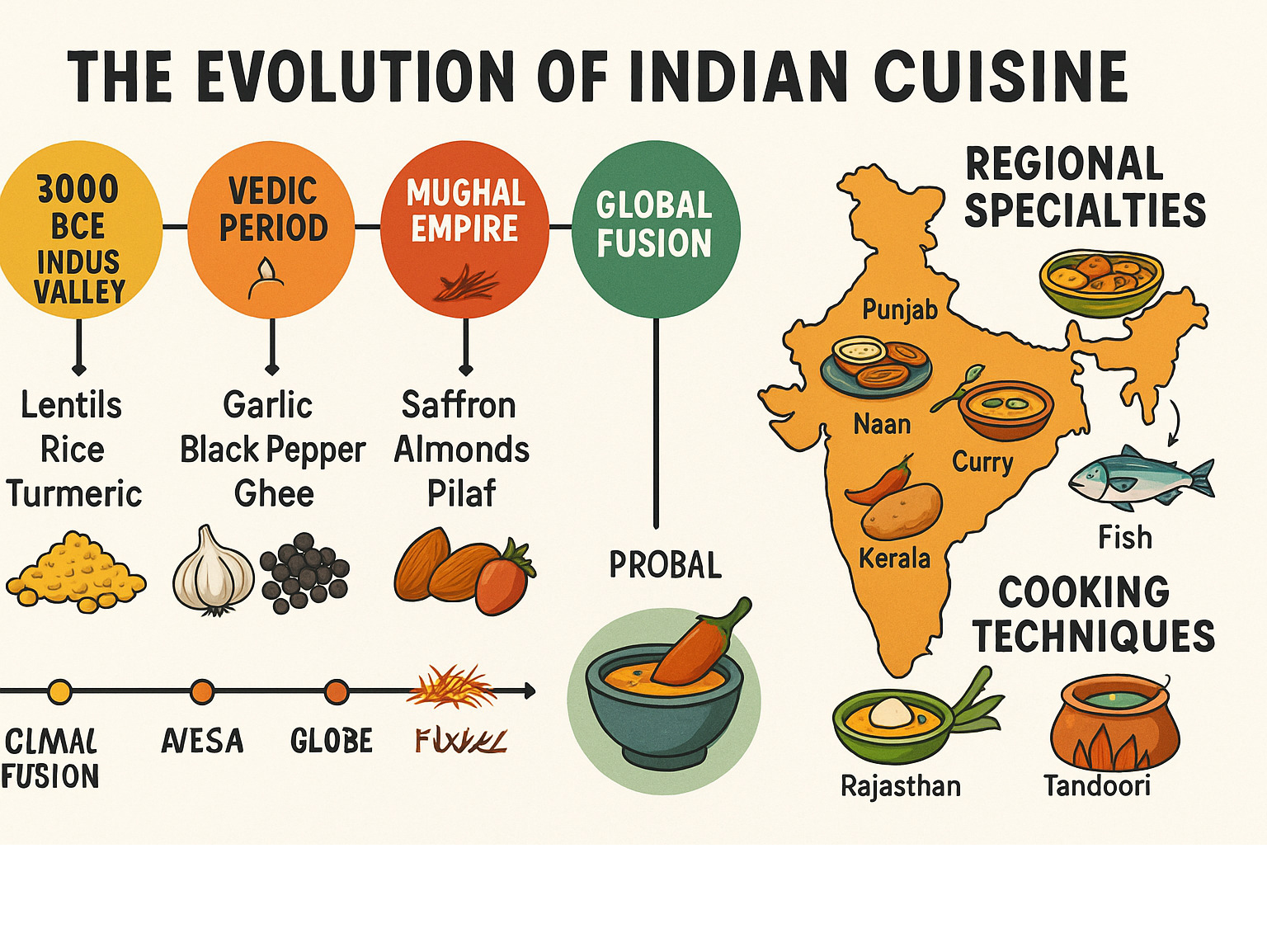
Indian food vocab explained:
What Makes Indian Cuisine Unique?
What sets indian food apart from every other cuisine in the world? It’s the way this incredible culinary tradition treats food as both nourishment and medicine, creating dishes that satisfy your taste buds while balancing your body’s needs.
Indian food emerged from thousands of years of cultural mixing. Ancient trade routes brought Persian techniques, Mughal refinement, and colonial ingredients into contact with indigenous cooking methods. The result? A cuisine that’s constantly evolving yet deeply rooted in tradition.
The ancient fusion philosophy runs deeper than just mixing ingredients. Indian cooks have always understood that great food comes from understanding how flavors work together, based on Ayurvedic principles that classify foods by their effects on mind and body.
Every traditional Indian meal aims to include six distinct tastes: sweet, salty, bitter, sour, astringent, and spicy. You’ll find all these flavors dancing together in a single thali, creating balanced eating experiences.
Tandoor cooking represents another uniquely Indian approach. These clay ovens reach 900°F, creating textures and flavors impossible with regular cooking methods. Flavor layering builds complexity through techniques like tadka (tempering) – heating whole spices in oil for 30-60 seconds to release essential oils.
Historical Influences & Evolution
The story of indian food stretches back to the Indus Valley civilization around 3300 BCE, where people grew wheat, barley, and rice. During the Vedic period (1500-500 BCE), food became medicine, with texts mentioning turmeric, ginger, and various lentils.
Persian and Mughal influences brought techniques like dum cooking (slow-cooking in sealed pots), giving us biryani. Mughal courts developed rich, cream-based curries, introducing nuts, dried fruits, and saffron.
Colonial exchanges introduced tomatoes, potatoes, chilies, and peanuts – ingredients now inseparable from indian food. Globalization continues this evolution today, with adaptations appearing in cities like New York City.
Role of Spices in Indian Food Identity
Spices don’t just season indian food – they define it. India produces 75 of the 109 spice varieties recognized internationally.
Garam masala demonstrates the Indian approach to spicing, combining cinnamon, cardamom, cloves, cumin, coriander, and black pepper. Turmeric serves as both spice and medicine. Chili peppers provide different experiences: Kashmiri chilies for color and mild heat, bird’s eye chilies for serious spice.
Tempering techniques showcase the scientific approach – when whole spices hit hot oil, they release essential oils in 30-60 seconds, creating flavor bases impossible to achieve with ground spices alone.
Core Ingredients & Signature Spices
The magic of indian food starts with understanding its foundational ingredients – carefully chosen building blocks that have sustained civilizations for thousands of years.
Rice reigns supreme across South and East India, from everyday boiled rice to fragrant basmati. Northeast India cultivates specialty varieties like black rice. Wheat and millet dominate northern regions, changing into chapati, paratha, poori, and tandoor-baked naan.
Pulses and legumes are the protein heroes. India consumes 27% of the world’s pulses – toor dal, moong dal, and chana dal provide essential protein, especially in vegetarian households.
Cooking fats tell regional stories: coconut oil in Kerala, mustard oil in Bengal, groundnut oil in Gujarat, while ghee remains the golden standard in North India. Each fat shapes entire flavor profiles.
Essential aromatics include ginger-garlic paste, curry leaves (beloved in South Indian cooking), and asafoetida (hing) – pungent raw but sweet and onion-like when heated.
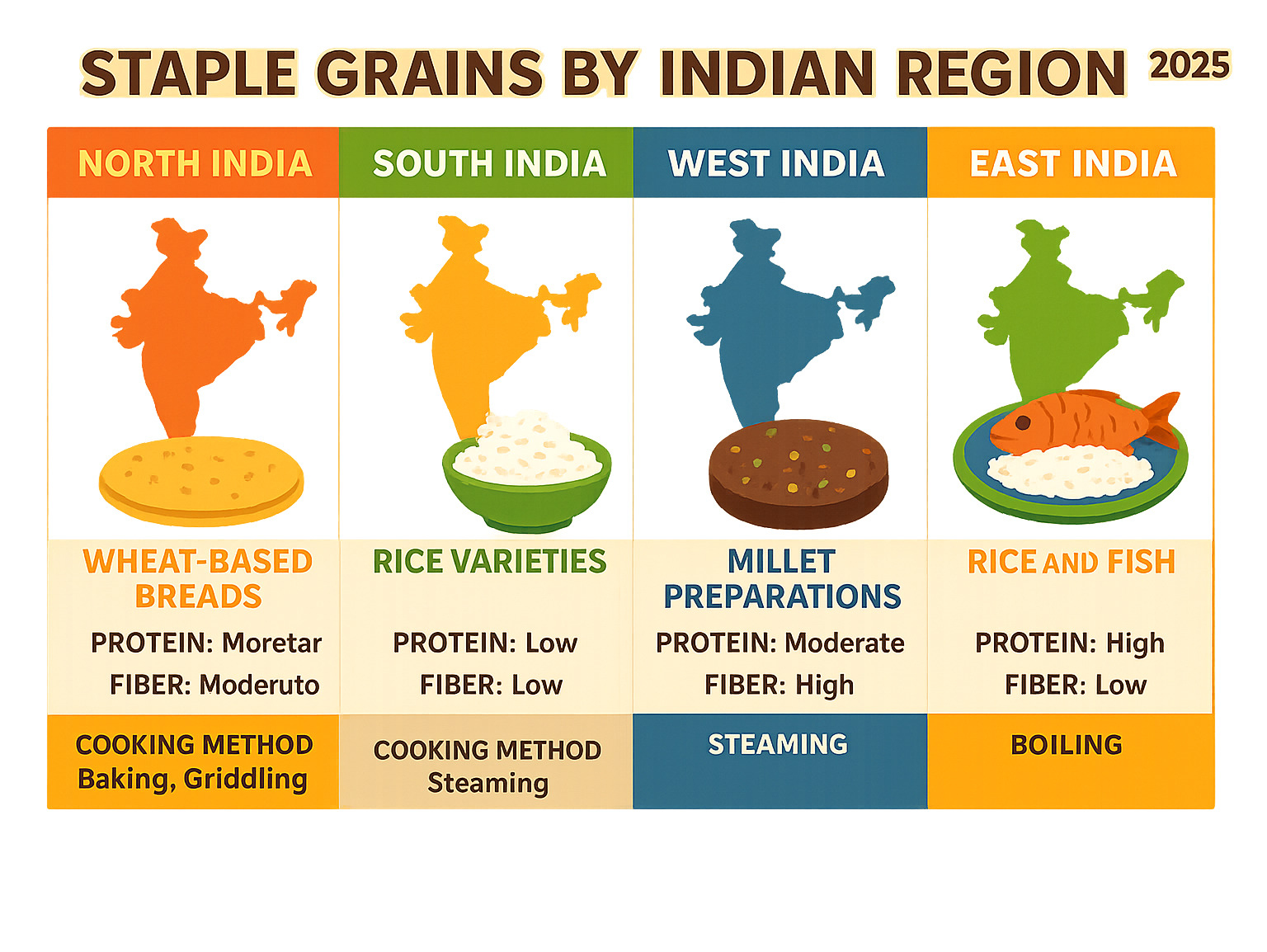
Must-Have Pantry for Cooking Indian Food
Getting started with indian food at home requires a few key tools and ingredients for authentic, enjoyable cooking.
A pressure cooker transforms cooking times for lentils from hours to minutes and creates perfect one-pot meals. Your spice grinder might be the most important upgrade – whole spices keep essential oils locked in until grinding.
A kadai (Indian wok) or heavy-bottomed pan provides control for tempering and slow-cooking techniques. Building your basic masala toolkit includes whole spices (cumin seeds, coriander seeds, cardamom), ground spices (turmeric, chili powder, garam masala), fresh aromatics (ginger, garlic, curry leaves), and specialty ingredients (asafoetida, tamarind paste, jaggery).
A traditional masala dabba (spice box) keeps essential spices organized and within reach, making cooking flow naturally.
Finding Indian Food Across Regions
The beauty of indian food lies in its incredible regional diversity – each area tells its own delicious story through local ingredients, cooking techniques, and cultural influences.
North India serves rich, creamy curries built around dairy – paneer, ghee, and yogurt-based marinades. Tandoor ovens produce charred breads and smoky meats. South India features rice, coconut, and fermentation techniques creating tangy dosas and fluffy idlis.
West India showcases contrasts from Gujarat’s vegetarian thali traditions to Goa’s Portuguese-influenced seafood curries. East India, particularly Bengal, celebrates fish with subtle spice blends. Northeast India offers unique fermentation techniques and bamboo shoot preparations.
Northern Indian Food Classics
Butter chicken – tandoor-roasted chicken in silky tomato-cream sauce, invented in 1950s Delhi. Naan requires tandoor’s blazing heat for characteristic bubbles and char. Tandoori preparations use 900°F clay ovens creating impossible-to-replicate flavors. Dal makhani transforms humble lentils into velvet-smooth comfort food. Chaat brings playful street snacks combining crispy, soft, hot, and cold elements.
Southern Indian Food Staples
Dosa represents fermentation mastery – rice and lentil batter fermented for hours, creating crispy crepes with complex flavors and probiotics. Idli uses the same batter but steams into spongy, cloud-like rice cakes. Sambar appears at virtually every meal – tamarind-sour, spicy lentil stew with seasonal vegetables. Coconut curries define coastal cooking, while filter coffee provides the regional caffeine culture.
Western & Coastal Delights
Goan vindaloo demonstrates cultural fusion – Portuguese “vinha d’alhos” transformed with palm vinegar and local chilies. Gujarati thali represents sophisticated vegetarian cooking with multiple preparations balanced for nutrition. Seafood curries celebrate Arabian Sea bounty with regional spice blends.
Eastern & Northeastern Specialties
Bengali macher jhol lifts freshwater fish cookery to art. Assamese cuisine incorporates bamboo shoots uniquely. Manipuri cuisine features fermented soybean preparations like hawaijar. Nagaland’s smoked pork challenges assumptions about Indian food.
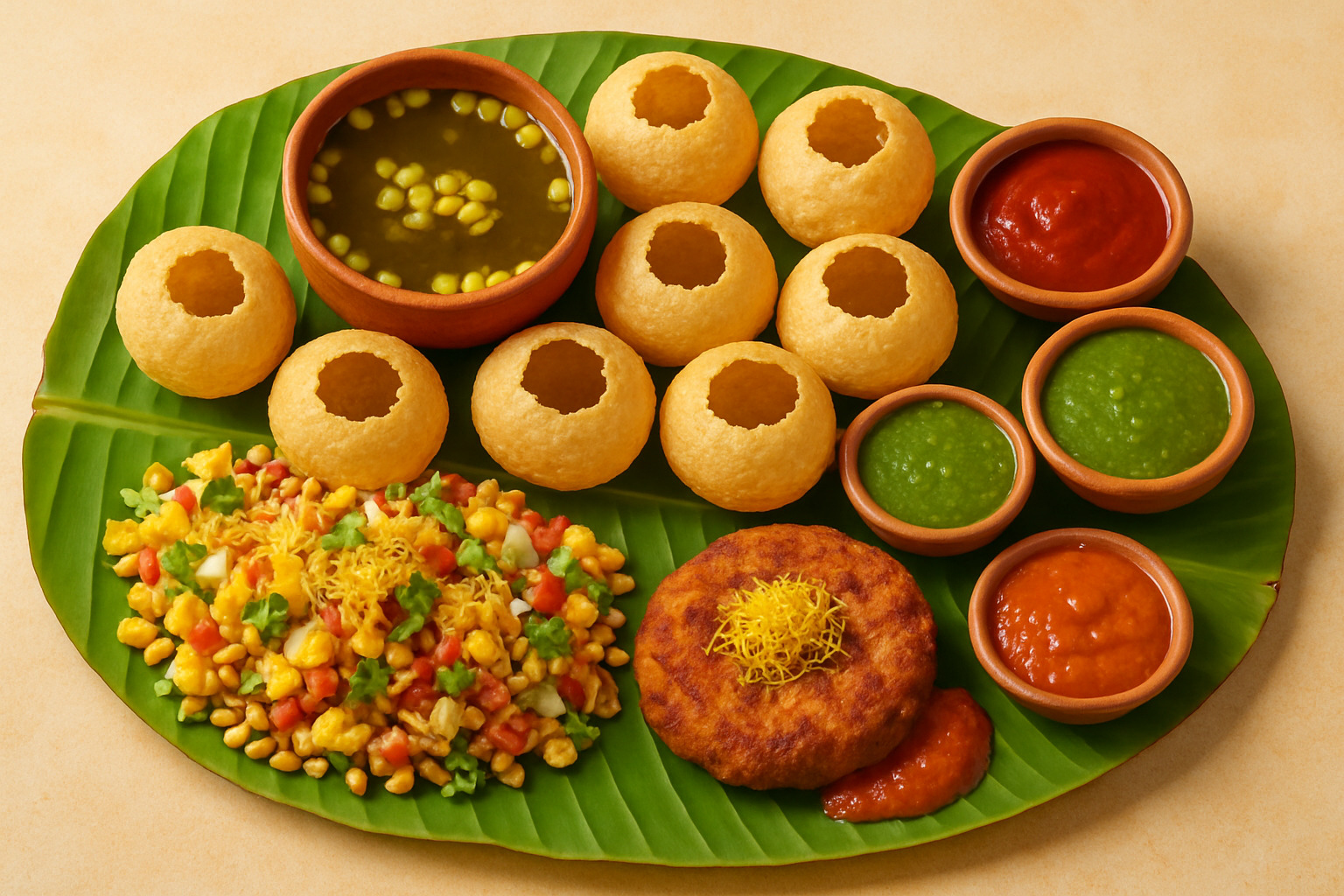
Eating Traditions, Street Fare & Modern Delivery
Indian food traditions encompass serving styles, eating etiquette, and social customs evolved over millennia. Thali service represents balanced nutrition with grains, proteins, vegetables, dairy, pickles, and sweets arranged in specific patterns.
Banana leaf meals in South India connect food with nature, providing antimicrobial properties and subtle flavors. Hand-eating etiquette using the right hand allows diners to gauge temperature and texture while mixing elements.
Street-Food Stars to Try
Indian street food showcases indian food at its most creative. Pani puri creates flavor explosions in single bites with crispy shells, spiced water, and chutneys. Vada pav, Mumbai’s signature, demonstrates urban adaptation – spiced potato dumplings in bread with chutneys. Chole bhature combines spiced chickpeas with deep-fried bread. Aloo tikki offers spiced potato patties with various accompaniments. Jalebi provides sweet spirals soaked in syrup.
How Indian Food Delivery Works in Montreal
Modern indian food delivery transforms access to authentic cuisine. Third-party apps dominate Montreal’s scene with real-time tracking and extensive options. Users filter by price, check ratings, and access free delivery through subscriptions. Specialty Indian grocers complement restaurants by providing ingredients for home cooking. Heat-and-eat options bridge restaurant meals and home cooking, requiring only 15 minutes for complete meals.
Health, Sustainability & Common Misconceptions
Let’s clear the air about indian food and tackle myths that might keep you from exploring this incredible cuisine. The World Wildlife Fund’s 2024 Living Planet Report ranks India’s food consumption as the most sustainable among G20 countries.
What makes indian food sustainable? The plant-forward approach central to Indian cooking for millennia. An estimated 30-40% of Indians follow vegetarian diets, with even non-vegetarian meals featuring vegetables and legumes as stars.
This plant-heavy approach delivers serious health benefits. High fiber from legumes and vegetables supports digestive health, while spices like turmeric and ginger provide powerful antioxidants. Traditional indian food preparation considers individual constitution and seasonal needs through Ayurvedic principles.
The protein question comes up frequently. India consumes 27% of the world’s pulses, providing essential amino acids, fiber, and minerals. Rice and lentils create complete proteins with all necessary building blocks.
Scientific research on dietary sustainability suggests adopting Indian dietary patterns could benefit both personal health and environmental sustainability globally.
The biggest myth about indian food: that it’s all blazingly spicy. Spice levels vary dramatically by region and dish. Many traditional preparations focus on aromatic spices rather than heat, building complex flavors through careful layering. The complexity comes from understanding how different spices work together – some for warmth, others for earthiness, still others for brightness.
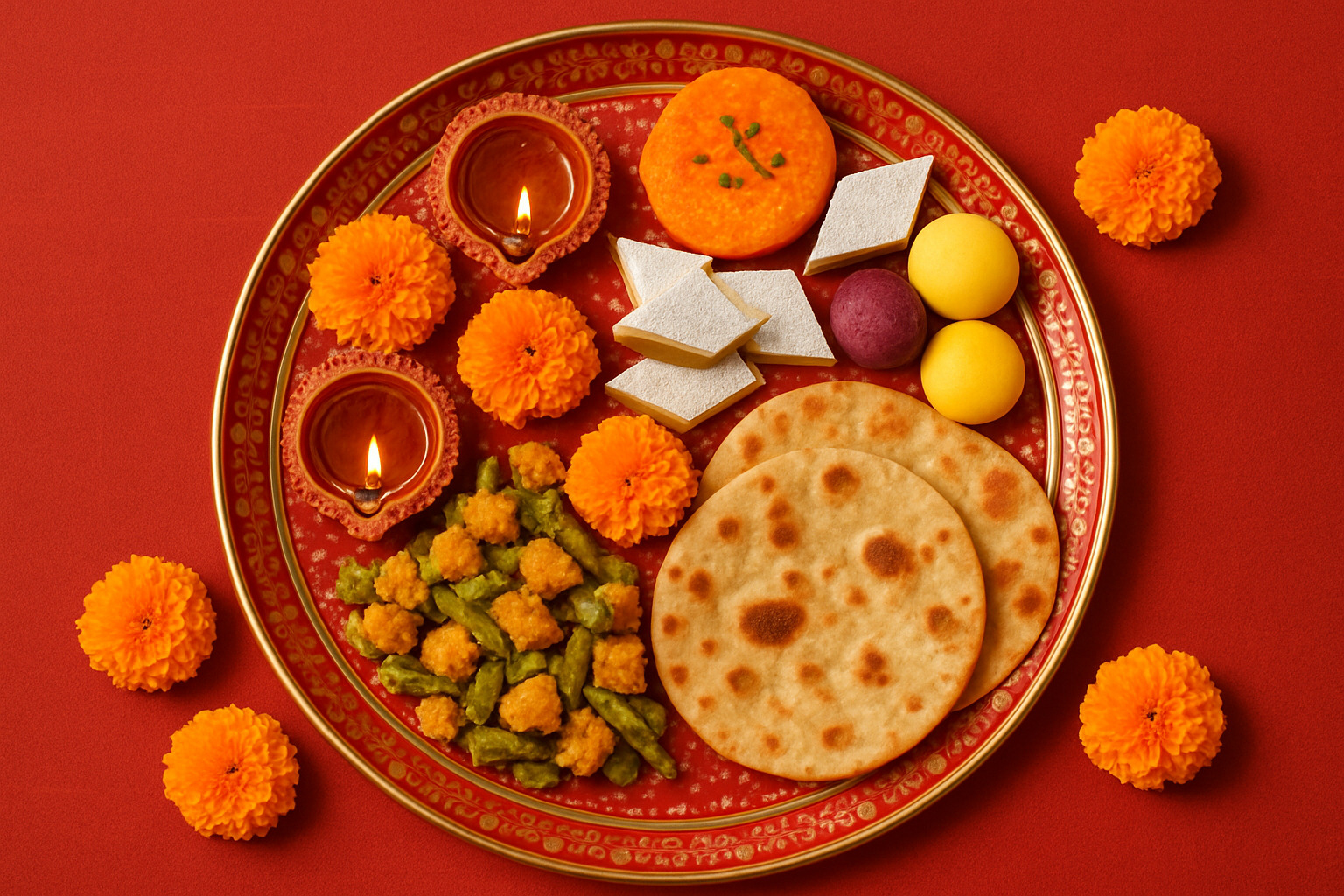
Festivals, Religion & Dietary Choices
Religious and cultural festivals profoundly influence indian food traditions, creating seasonal specialties and celebratory meals reflecting India’s spiritual diversity.
Diwali sweets represent elaborate food traditions with families preparing dozens of varieties – from coconut barfi to complex halwas – shared with neighbors to strengthen community bonds. Ramadan brings haleem – slow-cooked wheat, lentil, and meat stew providing sustaining nutrition for those fasting.
Navratri fasting transforms indian food during nine-day festivals, with devotees avoiding grains and certain vegetables, leading to creative preparations using buckwheat and water chestnuts. Jain satvik meals represent restrictive practices avoiding root vegetables and any foods harming living beings.
Religious dietary restrictions shaped regional development – some areas developed elaborate mutton preparations while others focused entirely on vegetarian options. Pescatarian coastal communities developed sophisticated seafood traditions while maintaining vegetarian principles for religious observances.
Ordering & Cooking Indian Food for Beginners
Starting your indian food journey doesn’t have to feel overwhelming. Understanding heat levels is crucial – most restaurants use 1-5 scales, but these can be subjective. Start with gentle options like butter chicken, korma, or tikka masala before progressing to medium-spiced dishes.
The curry versus masala distinction is simple: curry means “gravy” or “sauce,” while masala refers to spice blends. When cooking at home, start with fundamental techniques through dishes like dal tadka (teaching spice tempering), aloo gobi (dry vegetable preparation), and chicken tikka masala (curry-making basics).
Restaurant ordering improves with insider tips: mix textures by pairing saucy curries with dry preparations, include cooling elements like raita or lassi, and remember naan for scooping while basmati rice soaks up gravies.
Spice storage makes or breaks home cooking. Whole spices stay fresh longer and pack more flavor. Store in airtight containers away from light and heat. A dedicated spice grinder creates restaurant-quality results.
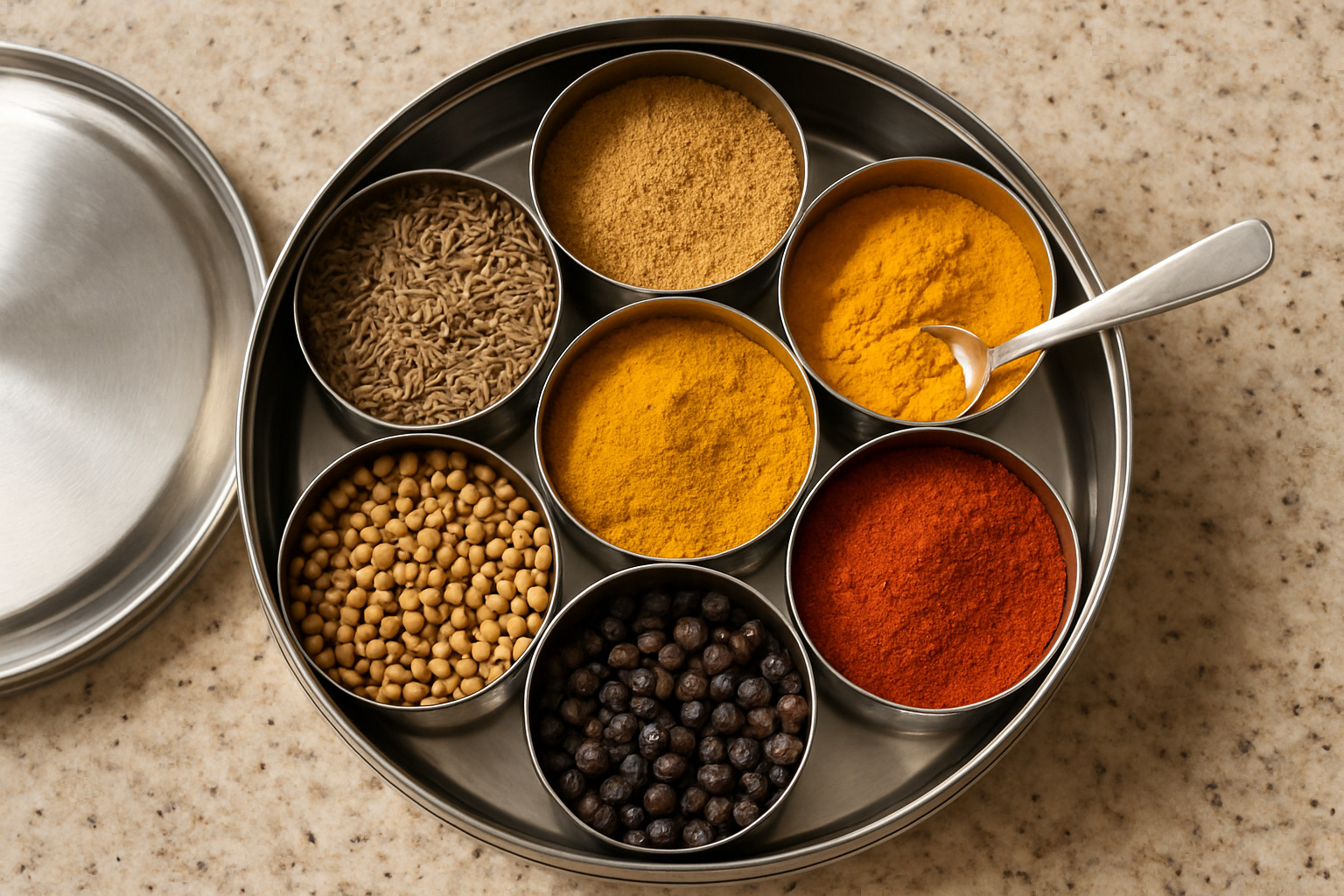
Indian food is incredibly forgiving – you can usually balance flavors if you add too much of one spice. The beauty lies in adaptability and how flavors develop over time.
Frequently Asked Questions about Indian Food
What makes Indian curries different from “curry powder”?
The difference between authentic indian food curries and commercial “curry powder” is like comparing a symphony to a single note. Real Indian curries start from scratch, with cooks selecting individual spices based on specific dishes, regions, and seasons.
Curry powder is a British colonial invention – it doesn’t exist in traditional Indian kitchens. Authentic curries might use twenty or thirty spices, each added at precisely the right moment through careful layering.
Is all Indian food excessively spicy?
This is the biggest myth about indian food. Many dishes are quite mild, focusing on aromatic spices like cardamom, cinnamon, and fennel rather than hot ones. North Indian dishes like korma and butter chicken are famously creamy and gentle. Even spicier regions use coconut milk, yogurt, and cooling herbs for balance.
How can I find authentic vegetarian options?
Indian food offers sophisticated vegetarian cooking developed over thousands of years. Look for South Indian restaurants or places specializing in Gujarati and Rajasthani cuisines. Focus on dishes designed to be vegetarian like dal preparations, paneer dishes, and fermented specialties like dosas and idlis.
Conclusion
Indian food represents far more than recipes – it’s a window into one of humanity’s most remarkable culinary journeys. From grains first cultivated 8,000 years ago to innovative fusion dishes appearing in New York City restaurants today, this cuisine tells stories of human creativity and cultural adaptation.
What truly sets indian food apart is how it makes the extraordinary accessible. A simple bowl of dal connects you with techniques passed down through generations. Street food from Mumbai corners or carefully prepared thalis let you participate in living traditions binding millions across continents.
The global love affair with indian food reflects its core philosophy – nourishing understanding of how food reflects identity, spirituality, and community. Every regional specialty carries stories of regional identity and family traditions.
Your culinary journey with indian food is just beginning. Start with familiar combinations but explore regional specialties – Bengali fish curries, Gujarati snacks, or dishes that redefine your understanding of this incredible food culture.
At The Dining Destination, we’ve seen how understanding indian food transforms people’s relationships with cooking and eating. Whether planning trips to explore authentic flavors, searching for the best restaurants, or stocking your spice cabinet, you now have the foundation to make every meal meaningful.
Ready to take your culinary exploration further? Our More info about culinary tours can help you experience indian food and other world cuisines in their authentic cultural contexts – because the best way to understand any cuisine is experiencing it where it truly lives and breathes.

